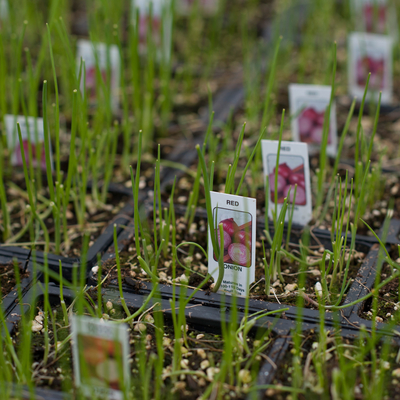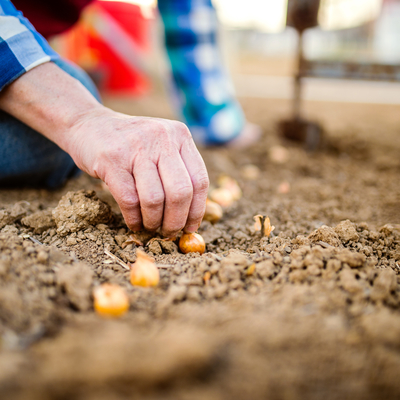How Often To Water Onions After Planting
A quick guide to onions
- Yous can grow onions from seed, transplants or modest bulbs chosen "sets."
- Plant onions early in jump.
- Soil for onions should be well-tuckered and loftier in organic matter.
- Onions are shallow-rooted and require constant moisture for proper growth.
- Harvest onions when about one-half the tops are falling over and dry.
- Curing is essential if you lot desire to store onions. Y'all must dry them in a warm, dry, well-ventilated expanse.
Long-day and curt-day onions
Onions (Allium cepa) have relatives that include garlic, chives, leeks and shallots.
Storage onions grown in Minnesota by and large are "long-24-hour interval" types that require fourteen or more hours of daylight to form bulbs. All onions require full sun for best growth. Overcast skies and cool temperatures during the growing season will delay bulb germination.
Sweet or balmy onions are "short-solar day" onions. Although you can abound them in Minnesota, they will generally develop small-scale bulbs. Bunching onions, including scallions and Egyptian walking onions, accept green stalks.
- Have your soil tested.
- Onions abound best in well-drained soil with pH between 6.0 and 7.0, and high organic matter.
- Apply phosphorus (P) and potassium (M) according to soil test recommendations. Many Minnesota soils take enough phosphorus.
- Unless your soil test report specifically recommends additional phosphorus, use a depression- or no-phosphorus fertilizer.
- Y'all can increment your soil's organic matter content by calculation well-rotted manure or compost in spring or fall. Do non utilise fresh manure equally it may contain harmful bacteria and may increase weed problems.
- Onions require a practiced supply of available nitrogen, simply likewise much nitrogen tin result in belatedly maturity, big necks that are difficult to cure, soft bulbs, green flesh and poor storage quality.
- Side dress with fertilizer after root systems are well-developed.
- Exercise this once or twice during the growing season, with urea (45-0-0) at a rate of 0.25 to 0.5 pound per 25 feet of row.
- Spread the fertilizer alongside the row of onions, well-nigh six inches away from the plants, and scratch it into the soil.
- Practise not use "Weed and Feed" type fertilizers on vegetables. They contain weed killers that will kill vegetable plants.
Direct seed as soon as the soil is workable in the spring.
- Sow seeds in a ii-inch wide band
- 1/4 to 1/2 inch deep
- in rows 12 to eighteen inches autonomously.
After seedlings emerge, sparse to iii to 4 inches autonomously.
Some seed companies sell onion transplants. They can tolerate calorie-free frosts, and you can plant them when temperatures achieve 50° F.
You tin can as well raise your own transplants by starting seed indoors ten to 12 weeks before planting outside.
Offset seeds indoors in February
- Sow seeds 3/4 of an inch deep.
- Go on evenly moist.
- Loosen plants when ready to transplant.
Transplant in May
- Trim roots to 1/ii inch.
- Trim tops to 4 inches long.
- Plant ii inches deep, 3 to 4 inches apart, in rows 12 to 16 inches apart.
You lot can besides plant onions from sets, which are small-scale bulbs grown the previous yr. Most of the sets bachelor in Minnesota are of the short-day type. If using sets, plant them every bit soon as the soil is workable in the spring.
How to keep your onion plants healthy and productive
|
- Onions are shallow-rooted and crave constant moisture for good growth.
- If the planting does not receive one inch of rain each calendar week, soak the soil thoroughly at least one time a calendar week.
- An inch of water will wet a sandy soil to a depth of 10 inches, a heavy clay soil to 6 inches.
- If your soil is sandy, it is important to water more often than one time a week.
- Use a trowel to see how far down the soil is wet. If information technology is only an inch or two, keep the water running.
- Stop watering when bulbs have reached total size and the tops begin to fall.
- Using a hoe or hand tool, make a shallow cutting to kill weeds just below the soil level before they get a problem.
- Exercise not hoe or chop also deeply.
- Mulch with herbicide-free grass clippings, weed-free harbinger, or other organic cloth to a depth of 3 to iv inches to help foreclose weed growth and reduce the demand for frequent tillage.
Insects are not a major problem with onions, although onion maggots can be a potential pest. Onion maggots diameter into establish stems, causing the plants to turn yellow and wilt.
For assist in diagnosing unknown problems, visit the University of Minnesota Extension diagnostic site "What'south wrong with my plant?"
Several kinds of rot can infect onions, including Fusarium basal rot, Botrytis cervix rot and bacterial soft rot.
To avoid diseases
- Use only healthy transplants or sets.
- Manage weeds in the garden and accept intendance not to hurt the onion bulbs.
- Resistant varieties are bachelor for Fusarium basal rot.
- Utilize proficient cultural control practices to reduce disease problems to a expert level and let for a successful harvest.
- Practice crop rotation. Plant in an expanse where yous have not grown onions, chives, leeks, shallots or garlic for the by iv years.
- Harvest onions when about half the tops are falling over and dry out. Undercut and lift bulbs with a spading fork.
- You can go out onions on the ground for several days if the weather will be dry out and warm, or bring them indoors to cure.
- Curing is essential if you programme to store your onions.
- Go on the onions in a warm (75°F - 90°F), well-ventilated surface area for 2 to four weeks, until outer bulb scales are dry and the neck is tight. Poor curing volition result in disuse during storage.
- When properly dry, you tin can braid the onions or cut the tops off.
- Store onions in a absurd, dry out surface area. Do not allow them freeze. They volition start to sprout if kept in a higher place 40° F.
Reviewed in 2020
How Often To Water Onions After Planting,
Source: https://extension.umn.edu/vegetables/growing-onions
Posted by: powellsence1948.blogspot.com




0 Response to "How Often To Water Onions After Planting"
Post a Comment